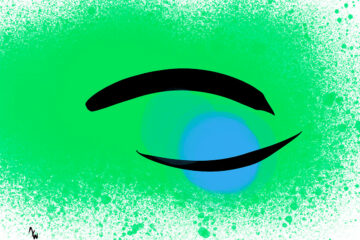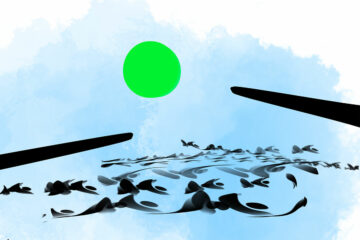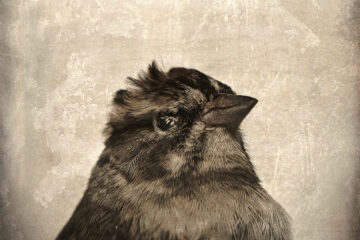‘Creativity’ is so broad. I’ve always approached creativity from the crafting and engineering side. I think that’s how my brain is wired.
Jordan Kerr, a leathersmith by profession and blacksmith by hobby, talks while sweeping the worn strip wood floor in his open studio and tidying up.
Today’s music of choice playing softly enough to talk above it is a Celtic punk channel on Pandora. Dropkick Murphys, among others, play from Jordan’s black-encased smartphone, tethered to a back-wall plug and resting on a table.
A studio artist for four years at the Manitou Art Center (MAC), Jordan has a 10’ x 10’ dedicated space. It fills one corner of the design studio on the MAC campus, which straddles 513 and 515 Manitou Avenue in Manitou Springs, Colo.
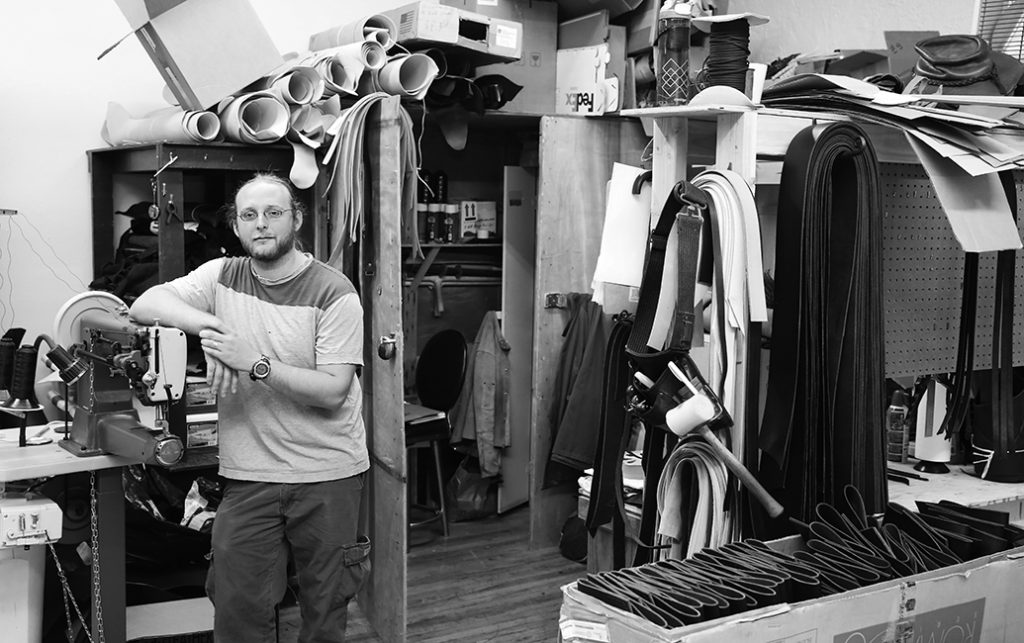
Having just come off the opening days of a seven-weekend Renaissance Festival in Larkspur, Colo., Jordan is reviewing inventory he noted on a yellow legal pad. It highlights material and product needs. He pulls cardstock sheath templates out out for tracing onto a thin, unrolled leather hide. Prep for his production work.
Jordan is a full-time leather craftsman. His steady stream of work fulfills a steady stream of commissions from Texas-based Legacy Forge.
He is one of six craftsmen — blades, armor, leather — who supply Legacy. Renaissance Festivals are the primary focus for sales. That’s where Jordan — “born and raised in Monument … never really lived anywhere but the Front Range” — got his start. With Legacy, with “Ren Fests,” with leather.
Jordan was hired 10 years ago, at age 20, to be a summer sales associate for Legacy Forge. “After a year, I got a permanent job with them to travel nationally to sell for them at Renaissance Festivals.”
Humanitou: How did you learn to leathercraft?
Jordan: Sheer, dumb luck. It was an offshoot of what I was doing at the Renaissance Festivals. That’s been the driving force in my life. I base most of what I do off the festival. It’s been my primary profession for 10 years.
I learned leathercraft at the festivals, by getting to see work from people like Joe Joe Ramirez, who’s been doing this for 50 years. Others there have been doing it for 40 years. I could see their work, watch them do the work, ask questions. My training very much was informal.
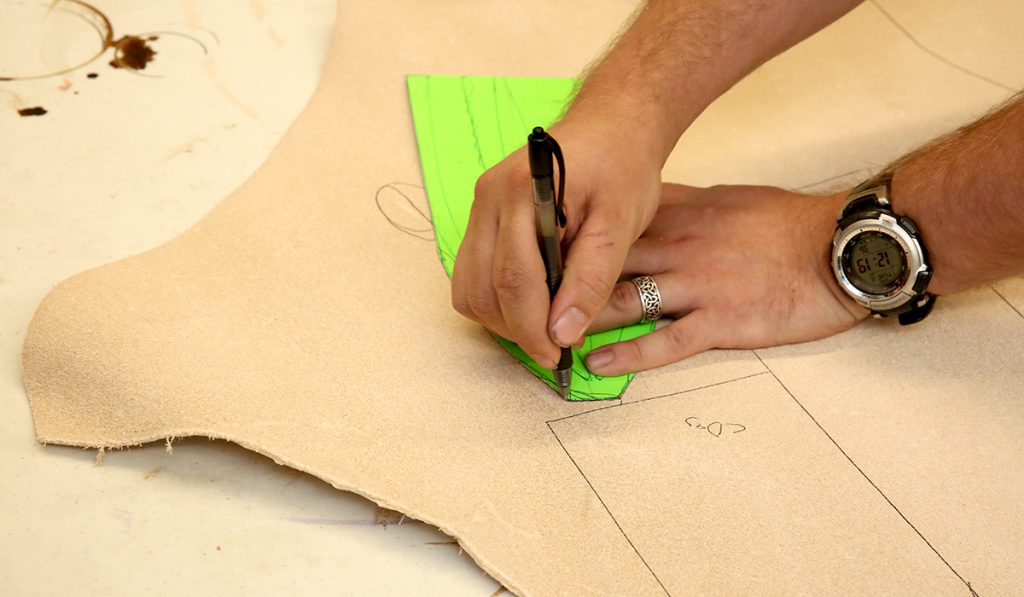
I’ve never been to a Renaissance Festival. Is this a period thing, where people dress in costume or is it about the skills or what?
(Laughs) Some people dress that way, I guess. But there’s very little attention paid to historical accuracy. It’s not a reenactment.
Renaissance Festivals are permanent sites with two- and three-story buildings with fully functioning kitchens. There are joust fields. There is an entire culture of people traveling to the two or three dozen shows nationally. Some are privately owned properties; only a couple are corporate-owned.
These festivals have some of the best hand-crafted, old-world kinds of goods. That’s where the really successful craftsmen are. It’s a weird venue and a weird way to sell, but you can’t do it that way if you’re not good and successful.
Most of the people who travel to the shows basically live out of their booths. They do production work in their booths, whenever possible.
When you sell your leathercraft at a festival, are you selling for yourself or for Legacy Forge?
Everything I make is commissioned by Legacy Forge. At festivals, I sell or manage sales at the booth on their behalf. (Jordan’s company is Evermore, Inc.)
Legacy is a collective of craftsmen across the country. The company sells hand-crafted arms and armor, every imaginable form of blade for sparring, reenacting, stage performing.
Jordan pulls a sword out of his plywood storage space in the corner, and draws his hand down the blade to show its blunted edge. He explains the edges are blunted because they primarily are intended for performing customers, like in TV, movies, Broadway shows and, a specific example, the Pirates of the Caribbean stage show for the Disney Cruise Line.
You create sheaths for the blades other Legacy craftsmen make, for example. Do you sell locally or have other leatherwork outside of Legacy’s commissions that you make?
Occasionally, I have other commissions. (He pulls out examples from his storage area.) These were shoulder pieces for clothing Angela designed.
(Jordan shows two hip pouches.) These were for a steampunk fashion show, for a clothing line of Angela’s, but I didn’t get them done in time.
(He mentions a leather corset that was part of a wedding dress commissioned by one of Angela’s clients.)
Basically, Angela gets commissioned for clothing designs, and she commissions my company, Evermore, Inc., to do the leathercraft.
Generally, I work full time for Legacy, leather crafting and working at festivals.
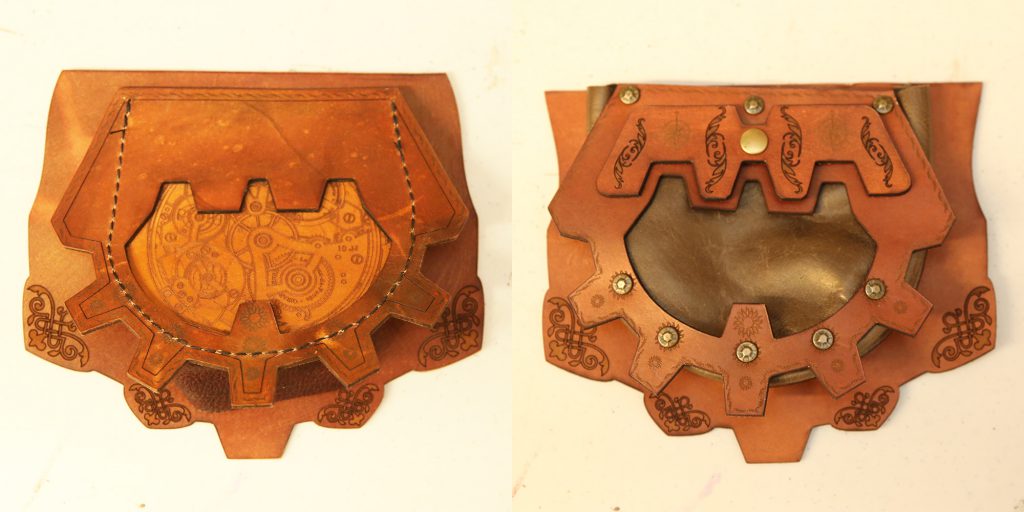
You also occasionally teach classes?
Last week I taught a 3-D printing class here at the MAC. I teach part-time at the Pikes Peak Makerspace. I also can teach laser engraving, but haven’t had one of those classes yet. I mostly am a resource about the tools here, and can teach people how to use them.
I’m familiar with about every tool that’s ever been here, at the MAC and when the Pikes Peak Makerspace had a space here, including welding. I studied welding in high school and got a welding certificate at Pikes Peak Community College. I have studied knife-making and tool-making, and am a blacksmith as a hobby.
I don’t honestly even think it’s particularly about the medium. I don’t consider what I do as artistic in the least.
I also took photography in high school and could futz my way through it again, but not in the photo workshop they have up there (second floor at MAC). I’d need a primer again about which chemicals to use in which order.
Pottery never really was my strong suit, but I know how to use a pottery wheel. Or more accurately, I know how to screw things up on a pottery wheel.
When the Pikes Peak Makerspace was located here (the makerspace consolidated its locations in downtown Colorado Springs this year), I used to work in the woodshop.
I love tools and technology. I’ve never met a machine I couldn’t figure out.
You have a broad maker experience. What is it about leather, why did you choose to go deeper with your art in leather rather than in one of the other areas you’ve learned?
I don’t honestly even think it’s particularly about the medium. I don’t consider what I do as artistic in the least. It’s all utilitarian, all with a functioning purpose. I think of myself as a good craftsman rather than a good artist. The creativity of it is in the efficiency, being effective and good with the process.
The side projects are creative to me, but I could do that with any medium, metal, plastic resin, wood.
I get a really good sensation for what I craft with leather because not many can do this. I don’t want to say leathercrafting is a dying art, but it’s way back in people’s minds. There are maybe only 10 people nationally who have the skills to do what I do, how I do it, and as well as I do it. To be good at this is satisfying.
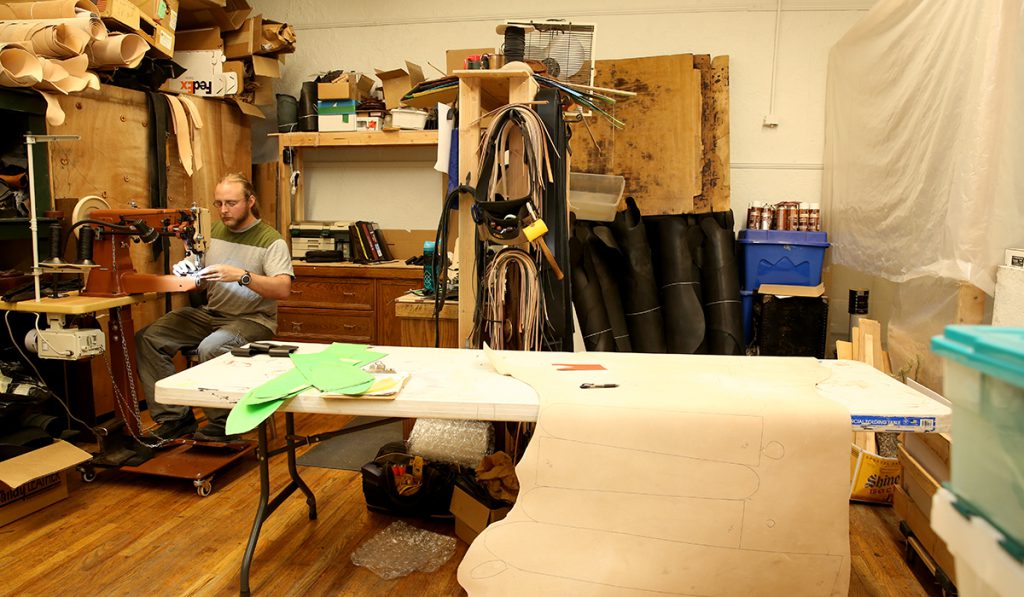
You’re not an artist? There’s more to that. What do you mean?
There’s a saying, art exists for its own sake. For something to be art or artistic, it exists for itself. A painting doesn’t produce something functional, it exists for itself. Now a door, for example, can be artistic, with scrollwork or painting or something that gives artistic creativity to the thing that has function. A stained glass window can be beautiful and function as a window.
It’s the difference of what is made to elegantly serve a function versus what is made only for beauty, or taking something already made that then is added to to make it beautiful.
I make very few things just for the sake of being artistic. I try, I’m just not very good at it. It short circuits my brain. (laughs) There are only a couple months a year I even try to create like that.
But I’d also say everybody’s skill has an art form to it. You can be a creative car mechanic, creative cook or creative anything else. It’s kind of a kung fu mentality, the philosophy that everything has a basic form and art to it.
I consider myself to be a creative crafter, a creative engineer, a creative smith.
I could sit at a computer and draw everything in this room, but I couldn’t take a pencil and do it. I can sketch just fine, but to process translating the room into a drawing … I just can’t make things that way. The thought of taking an idea and turning it into a painting or drawing or sculpture, it’s just not what I can do.
I make things from a mechanical side. Both have creativity and art that are possible. I just really can only see it from one side.
Craft and production are your focus.
I think people underestimate how things are made. Like, ‘If you had one day, could you make a pencil? Could you figure out how it’s made and figure out how to make it yourself?’ It’s something we use everyday.
That’s the thing about makerspaces and hackerspaces, once you figure out how something works, you can figure out how to change it. That really is the concept of hacking.
From what I’ve experienced and read about those spaces, they all seem to share a common idea that we can change things, that we can either make new things or figure out a way to use things in a way never done before.
It’s the idea of not looking at an object and asking, ‘What does this thing do?’ but asking, ‘What can I make this thing do?’ It’s an entirely different perspective.
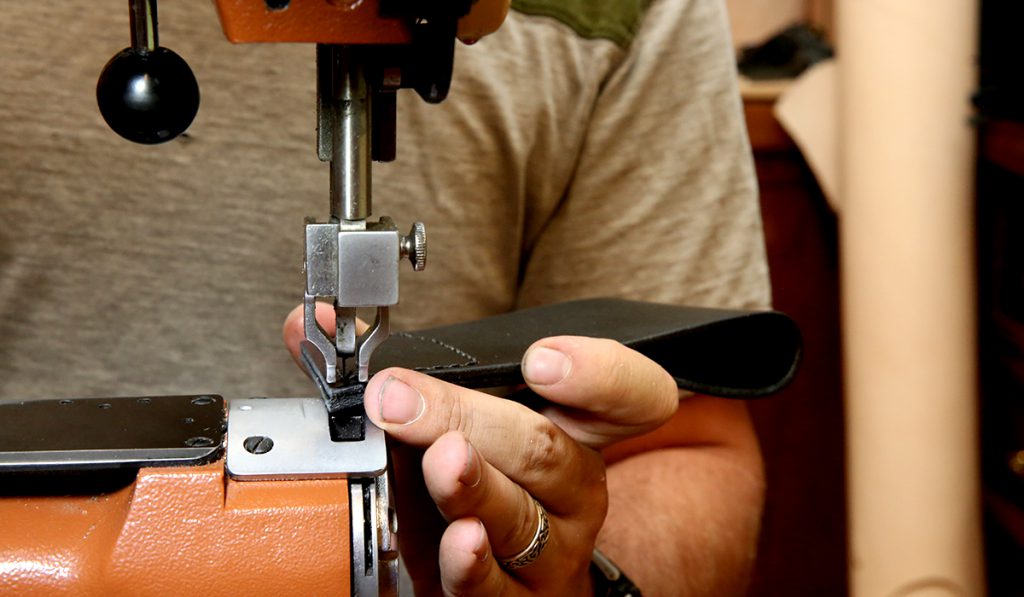
Has living in Manitou had special impact on you and your craft?
The art center itself is what’s allowed me to do such a great range of work. To have a place to go rather than to work in my basement or garage is very helpful.
I don’t know if the culture of Manitou Springs has influenced my work because I don’t approach it from the purely artistic side. The Pikes Peak Makerspace did. Working with new tools like laser cutting and 3-D printing made me ask, ‘How can I leverage those tools in what I make?’
Living in Manitou, it’s a really nice place to be. If you’re someone who wants to be surrounded by creative people, this is a great place to be.
There is a creative arts community here, but not so much in leathercrafting. Is that a factor for you?
That’s true. But I’m not sure there’s a leathercrafting community at all. Tandy Leather is a pretty big name and everybody who works in leather passes through there. Generally, the only place I run into other leathercrafters is at Tandy. There are only four people in Manitou who work with leather, and I know all of them.
You’ve described yourself as a production craftsman. In this town of artists you don’t feel like you quite align with in your approach, would you say you’re a leather artisan?
No, I’m not an artisan. I’m a leathercrafter. I use leathersmith because it sounds less kinky than leatherworker. And it gives it more of that old-world tone.
I view crafter and artist as interchangeable, I guess. Defining artisan, I derive artist from that, someone with a drive, study and intent in producing art.
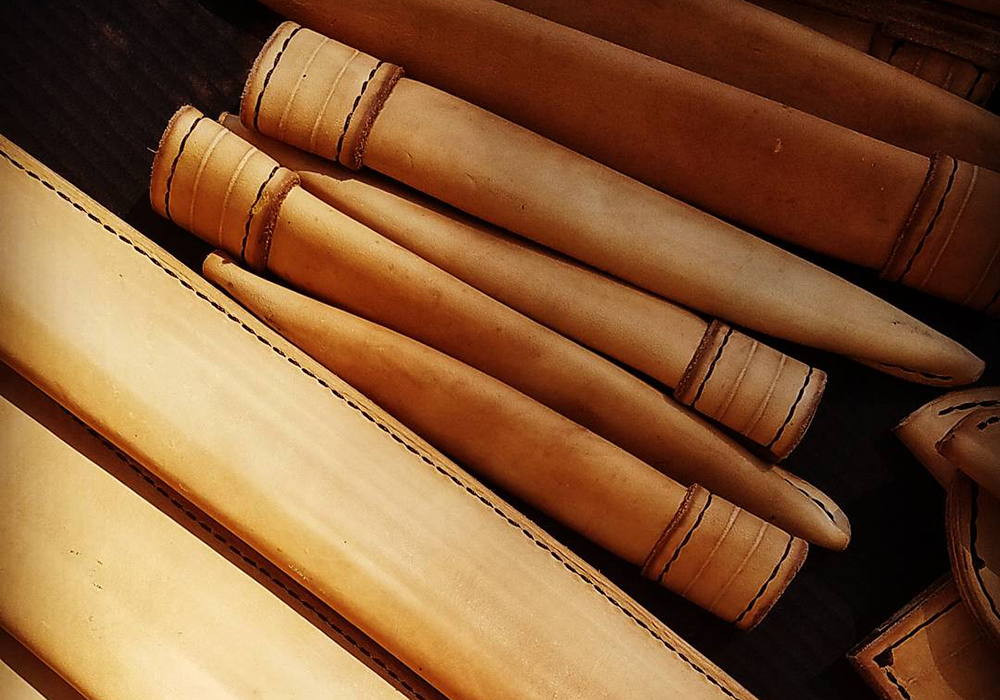
The notion of art seems to mean original, abstract creativity in your mind.
(nods agreement) Creating something from nothing like that is a long drawn-out process for me. And mostly it’s derivative for me. I’m a great technician. I can adapt things well. It’s application of form versus generating it, in my mind. That’s different.
Let’s go back to what you were saying about the kung fu philosophy, about there being art in every skill. It’s a similar view to how I’m broadly describing art and creativity for Humanitou’s purposes, that it applies to people’s passions and isn’t limited to painting, sculpting, pottery, etc.
The kung fu mentality says the more you learn and master something, the better and easier it becomes for you. You’re doing something for the sake of excelling, and being mindful of being increasingly skilled at that thing.
The idea is that kung fu is in everything, that everybody’s skill has an art to it.
